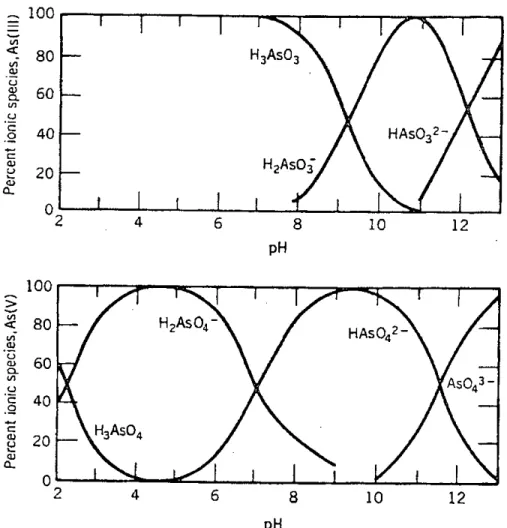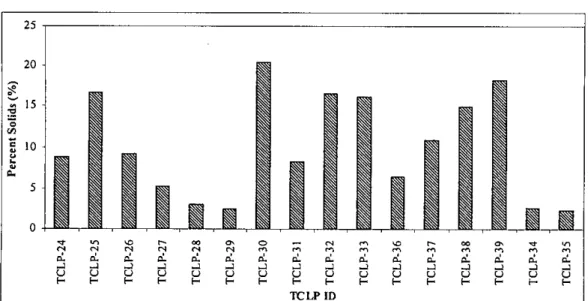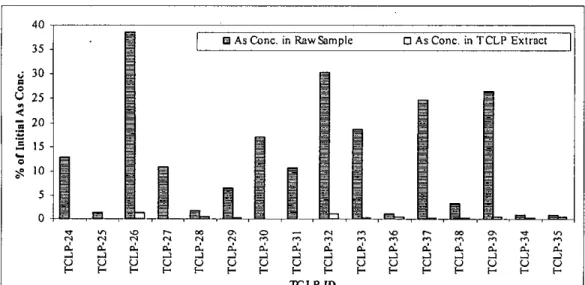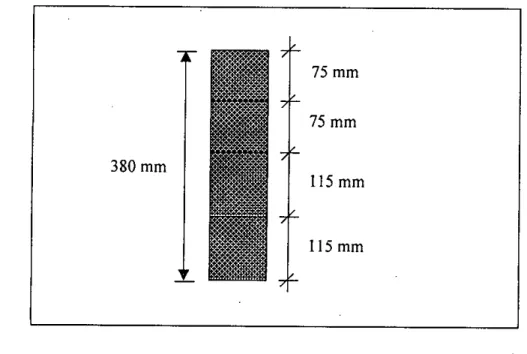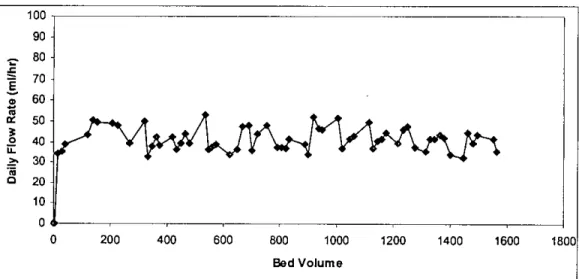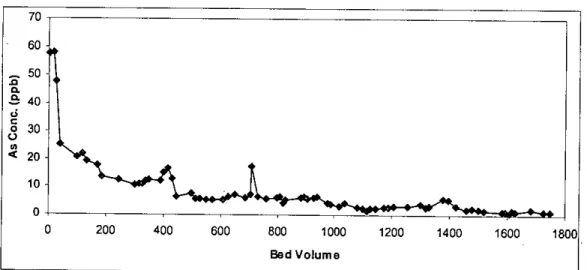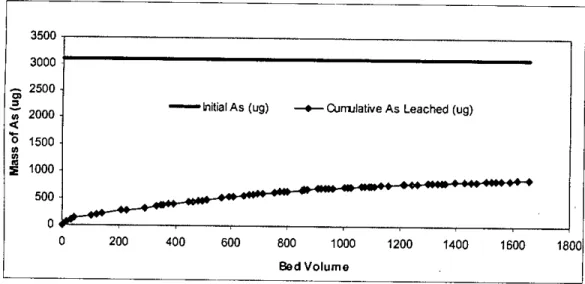We hereby recommend that the thesis entitled "Short-Term and Long-Term Leaching of Arsenic from Wastes of Arsenic Removal Systems" submitted by Md. Leaching of arsenic from slurry waste samples from 'STAR' and 'BUET-UNU' bucket treatment units, expressed as % of the initial As concentration in the waste.
GENERAL
Since then, high levels of arsenic have been found in 61 of the country's 64 administrative districts (Ali et. ai, 2003). Also, some of the arsenic removal units generate liquid sludge containing high level of arsenic associated with iron flake.
OBJECTIVES OF RESEARCH
SCOPE OF THE STUDY
RESEARCH METHODOLOGY
ORGANIZATION OF THE THESIS
INTRODUCTION
ARSENIC IN THE ENVIRONMENT
Arsenic is mainly found in the form of its mineral compounds and is widely distributed in air, water, soil, rocks and Earth's crust. It is clear that rocks and minerals are the main reservoirs of arsenic, which is mobilized in the other media of the world.
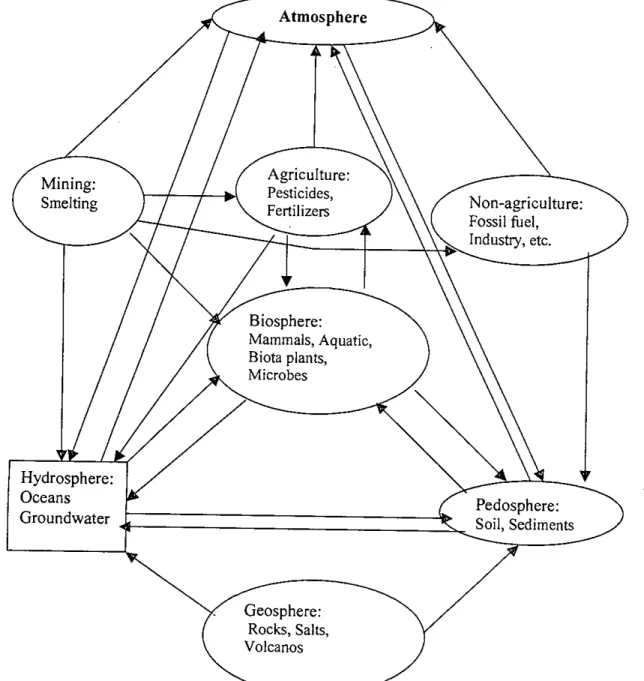
USE OF ARSENIC .1 Historical Uses
Modern Uses of Arsenic
Arsenic compounds are used as components in pesticides and preservatives of electricity poles and other wood, leather and the like as shown below in table 2.2.
SOURCES OF ARSENIC
The concentrations of arsenic in natural reservoirs in relation to soils are shown in Table 2.4. However, it can be confirmed that the contamination of arsenic in groundwater comes from the geological sources.
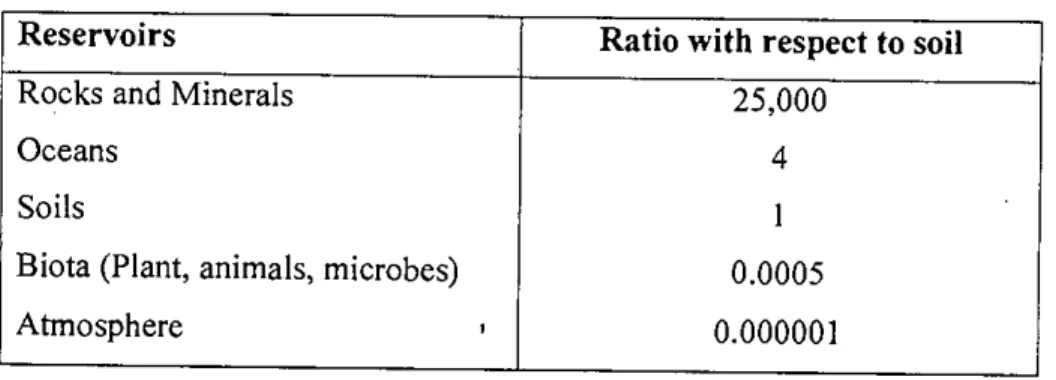
CHEMISTRY OF ARSENIC
Properties of Arsenic
Arsenic oxide, commonly known as white oxide, is the material most widely used for the synthesis of arsenic compounds. Other arsenic hydrides are diarsine (As2H.), diarsine hydride (As2H2) and polymeric diarsine monohydride (As2H)x.
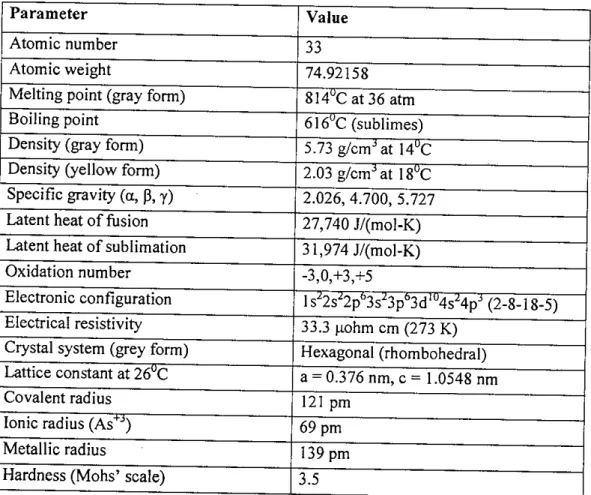
Acid-Base Reaction
The mobility of arsenic is controlled, in large part, by redox transformations. In the underground environment, the adsorption-desorption of arsenic on iron oxyhydroxides is an important mechanism that controls its mobility.
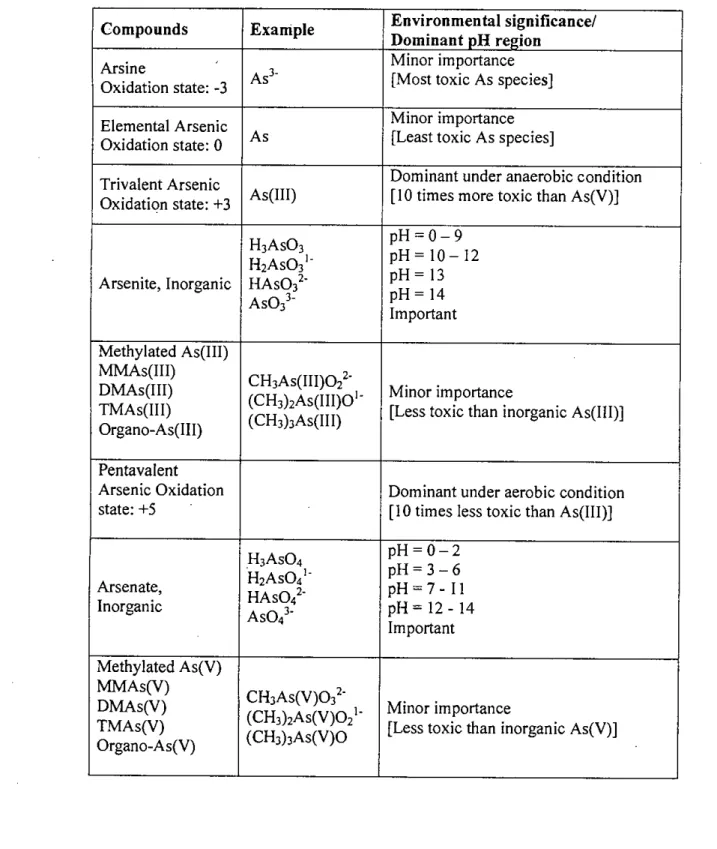
Precipitation and Dissolution Reactions
The sulfide As2SJ has its lowest solubility at pH 4, but this solubility is significantly higher than generally accepted (Robins et al., 2001). Ferric arsenite sulfate is also of recent interest and may prove useful in stabilizing arsenic (III) (Robins et al., 2001).
ARSENIC IN SOIL
ARSENIC IN ATMOSPHERE
It has been estimated that the Ronnskar smelter in northern Sweden released 50-115 tons of arsenic per year, a gold smelter in Yellowknife, Canada released 19-2600 tons of arsenic per year, and the release of the ASARCO smelter in Tacoma , Washington was about 7- I 52 tons. A pyrite combustion plant in Barreiro/Seixal, Portugal is known to release 1000-2000 tons of arsenic into the atmosphere annually (Nriagu &. Pacyna, 1988).
METHYLATION REACTIONS
Coal combustion has been estimated to contribute about 11% of arsenic emissions to the atmosphere. A type of coal-burning arsenic poisoning is the result of domestic burning of coal containing high levels of arsenic (90-2 100 mg/kg).
OH a/llenlte I
HEALTH EFFECT OF ARSENIC .1 Introduction
The effect of arsenic after inhalation or food and drink depends on the amount and the physicochemical state. The chronic toxicity of arsenic is in terms of affecting organs and systems, the skin, the nervous system, the liver, the cardiovascular system and the respiratory tract.
ARSENIC CONTAMINATION IN BANGLADESH
The estimates of total population exposed to arsenic concentration above 50 and 10 ppb using kriging method were 35.2 million and 56.7 million respectively. Based on upazila statistics, the exposure levels to arsenic concentration exceeding 50 and 10 ppb were 28.1 million and 46.4 million respectively.
AN OVERVIEW: LEACHING OF ARSENIC FROM WASTES
But till now the ground water in the northwestern zone of Bangladesh is relatively free of arsenic. Due to pH dependence of arsenic desorption, changes in groundwater pH can promote desorption of arsenic.
CHAPTER-3
SHORT-TERM LEACHING OF ARSENIC
- INTRODUCTION
- ASPECTS OF LEACHING
- Waste Reactivity Screening
- TOXICITY CHARACTERISTIC LEACHING PROCEDURE (TCLP) .1 Scope and Application
- Preliminary Determination of Percent Solids
- Determination of Appropriate Extraction Fluid
- Analysis of TeLP Extract
- MATERIALS AND METHODS
- Carrying out TCLP
- RESULTS AND DISCUSSION
- AN OVERVIEW: SUMMARY OF SHORT-TERM LEACHING
Simple screening level leaching tests can be performed on waste products to assess the relative reactivity of the waste. C1 =Concentration of analyte of concern in first stage (mg/L) V2=Volume of second stage (L). None of the solid samples collected from the various arsenic removal units fell into the category to be specified as hazardous material as defined by the USEPA.
For the majority of the slurry samples, leaching of arsenic, expressed as a percentage of initial arsenic present, was negligible. Although initial arsenic concentration of some of the solid waste samples was extremely high, percent leaching was quite low.
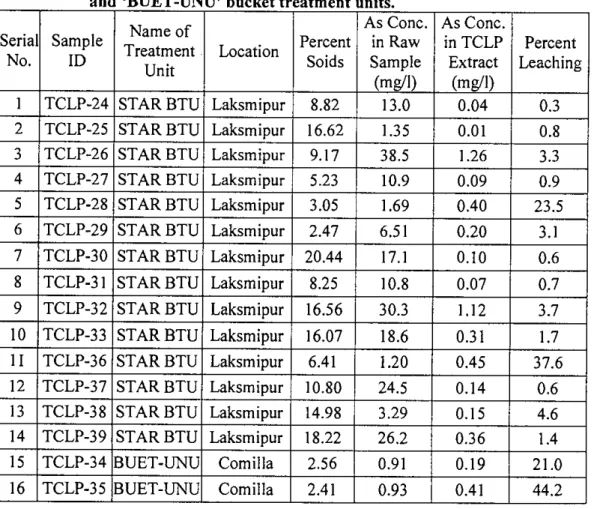
CHAPTER-4
LONG -TERM LEACHING OF ARSENIC
INTRODUCTION
LONG-TERM LEACHING OF ARSENIC
MATERIALS AND METHODS
A portion of the dried sample was used to perform the sieve analysis for particle size distribution of the waste. In this study, a total of five columns were set up to investigate the leaching properties of the waste by passing five different types of water through the column. A small bucket placed directly below the column collected the leachate that came out of the column after passing through the material in the column.
It also helped to prevent sample particles from clogging the narrow opening of the column through which the leachate was collected. A portion of the sample from each segment was digested and analyzed as before for the determination of arsenic content.
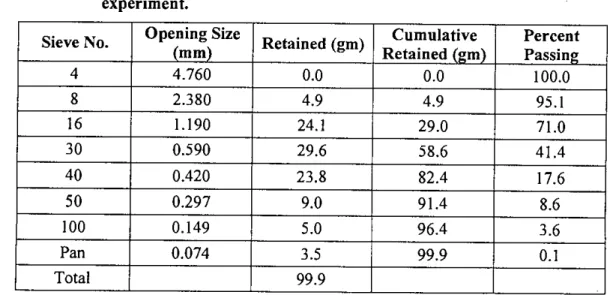
RESULTS AND DISCUSSIONS
As in the case of column I, there was a small variation in the daily flow rate as a function of the bed volume passed through the column. In column 3, rainwater was passed through the filter media in the column to assess the leaching properties. During this period, 77 leachate samples were collected and 1720 bed volume (equivalent to 1116 liters) of pond water was passed through the filter media into the column.
In column 5, extraction liquid # I was passed through the filter media in the column to evaluate the leaching properties. During this time period, 89 leachates were collected and 1929 bed volumes (equivalent to 130 liters) of extraction liquid # I were passed through the filter media in the column.
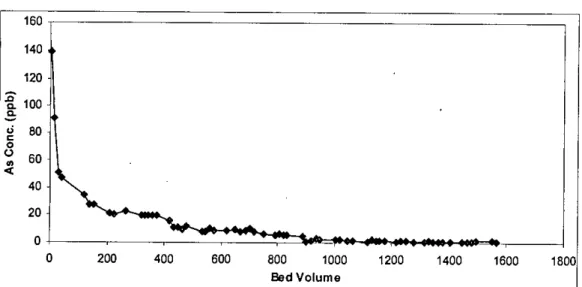
GENERAL DISCUSSION
This also applies to the amount of water (liquid) that passes through the filter media in the different columns. The smallest volume (1564 bed volumes) of water was passed through column I, while the largest volume (1929 bed volumes) of extraction liquid # I was passed through column 5.
MASS BALANCE
It can be seen from table 4.3 that there was 1698 Ilg of arsenic left in the waste sample after the end of the column test. It can be seen from Figure 4.15 (also from Table 4.3) that there was little variation in the leaching of arsenic from different depths of the column. However, the reason for leaching of arsenic from different segments in such a pattern is not clear.
The calculated percentage of arsenic leaching from different segments of other columns is shown in Figures 45 to 50 in Appendix C. The tables in Appendix D show that the cumulative leaching of arsenic from column 2, column 3, column 4 and column 5 is 871 j1g is.
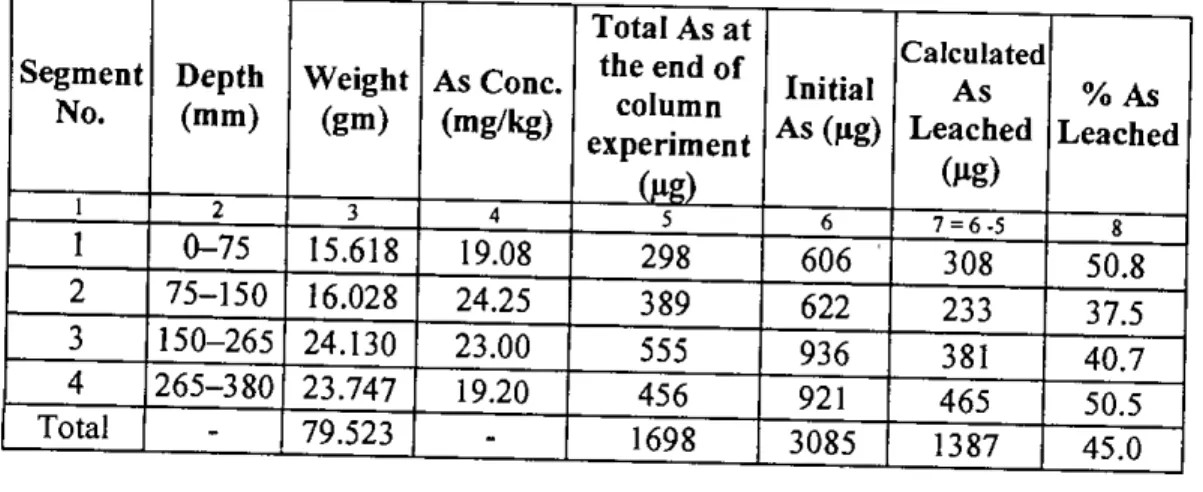
AN OVERVIEW: SHORT-TERM AND LONG-TERM LEACHING _ A BRIEF COMPARISON
Column experiments were conducted to evaluate the long-term leaching characteristics of the solid waste samples collected from filtration-based arsenic removal units. Although the initial arsenic content was the same (38.80 mg/kg) for all cases, there is great variation in short-term leaching and long-term leaching. From the above discussion, it can be easily seen that long-term leaching causes greater release of arsenic than short-term leaching.
Short-term leaching was found to be less than 2% for five types of fluids while long-term leaching (column leaching) was found to be between 22.7% and 35.3%. From the above results and discussions, it can be concluded that the TeLP tests are not suitable for the assessment of long-term arsenic leaching as well as for the stabilization of treatment residues.
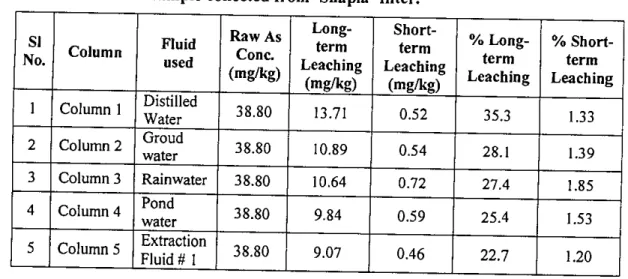
CHAPTER-S
CONCLUSIONS AND RECOMMENDA nONS
INTRODUCTION
CONCLUSIONS
Therefore, pollution potential is higher if the waste is subjected to long-term leaching in an environment such as pond, open surface, etc. It can be concluded that TCLP is not suitable for the assessment of long-term leaching of arsenic. Hence, it is not safe to dispose the arsenic rich waste generated from different arsenic removal units in the open environment.
The indiscriminate disposal of arsenic-rich waste can cause an environmental hazard by releasing a significant amount of arsenic after a significant period of time.
RECOMMENDATIONS
M Arsenic leaching from wastes of arsenic removal systems" In: Proceedings of the BUET-UNU International Symposium on the Fate of Arsenic in the Environment, Ahmed, M. Standard Methods for the Examination of Water and Wastewater, 20th Edition, American Public Health Association, Washington, D.C., pp. Study of Arsenic Treatment Technologies and Leaching Properties of Arsenic Contaminated Sludge", In: Proceedings of the BUET-UNU International Workshop on Arsenic Removal Technologies from Drinking Water, Ahmed, M. Arsenic Leaching from Iron Oxide Impregnated Brick Sand (Shapla Filter Media ) using common chemicals and water". In: Proceedings of the BUET-UNU International Symposium on the Fate of Arsenic in the Environment, Ahmed, M.
Review of Arsenic Removal Technologies in BUET, In Bangladesh Environment- 2000, M.F.Ahmed (Ed.), Bangladesh Poribesh Andolon Arsenic Removal in Hand Pump Linked Iron Removal Plants in Noakhali, Bangladesh", Presented at the International Conference on Groundwater Pollution by of Arsenic in Bangladesh: Causes, Consequences and Solutions, Dhaka, 8-12 February Arsenic removal from wastewater and stabilization of arsenic-containing wastes: summary of experimental results, J.
APPENDIX A: DETAIL RESULTS OF COLUMN EXPERIMENTS
APPENDIX B: TCLP DATA SHEET (SOLID AND SEMI-SOLID SAMPLES)
Viii: Badarpur Viii: Badarpur Viii: Bashkimi Badarpur: Bashkimi Ashwadia: Bashkimi Ashwadia: Ashwadia Vendndodhja Thana: Noakhali Thana: Noakhali Thana: Noakhali. ViII: Badarpur ViII: Badarpur ViII: Badarpur Bashkimi: Ashwadia Union: Ashwadia Union: Ashwadia Vendndodhja Thana: Noakhali Thana: Noakhali Thana: Noakhali. Viii: Badarpur ViII: Badarpur Viii: Bashkimi Badarpur: Bashkimi Ashwadia: Bashkimi Ashwadia: Ashwadia Vendndodhja Thana: Noakhali Thana: Noakhali Thana: Noakhali.
ViII: Badarpur ViII: Badarpur Viii: Badarpur Union: Ashwadia Union: Ashwadia Union: Ashwadia Lokacija Thana: Noakhali Thana: Noakhali Thana: Noakhali. Vill: Badarpur ViII: Badarpur Vill: Badarpur Union: Ashwadia Union: Ashwadia Union: Ashwadia Lokacija Thana: Noakhali Thana: Noakbali Thana: Noakhali.
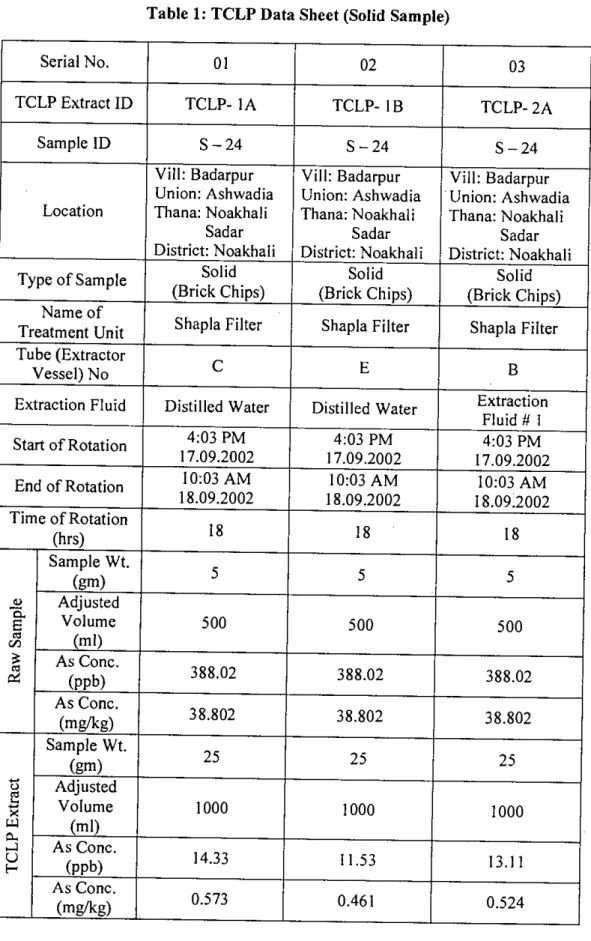
APPENDIX C: GRAPHS
Cumulative flow rate as a function of bed volume of liquid passed through the column (column ID: C-3, liquid: rainwater).
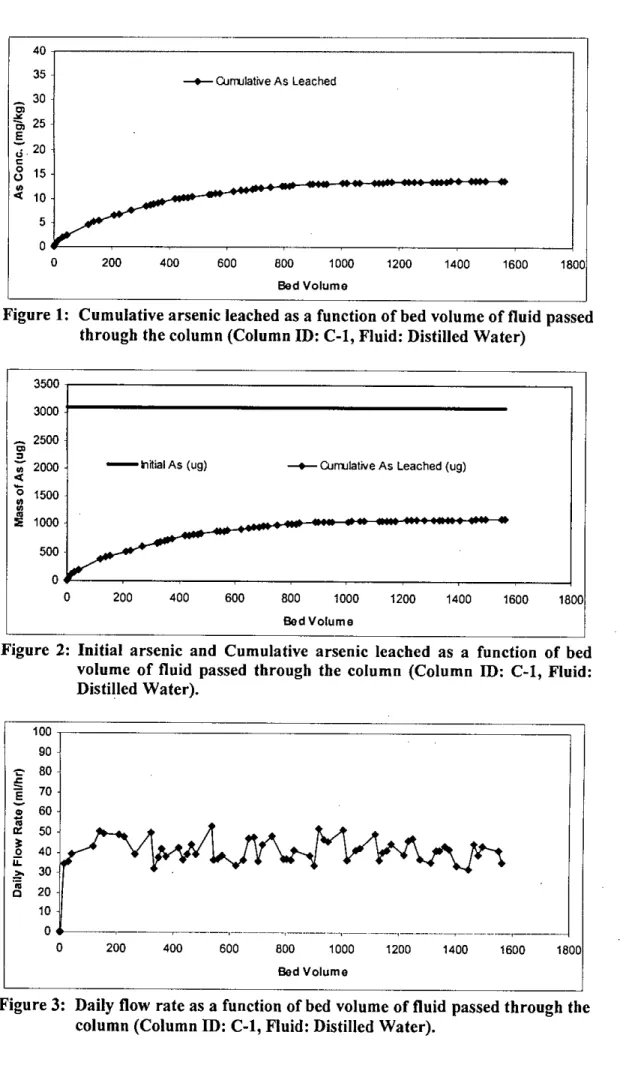
III ••
Total amount of arsenic leached, arsenic remaining and mass balance error of arsenic in column 2 (Column ill: C-2, Liquid: . Groundwater). Total amount of arsenic leached, arsenic remaining and mass balance error of arsenic in column 4 (Column ill:C-4, Liquid: Pond water). Total amount of arsenic leached, arsenic remaining and mass balance error of arsenic in column 3 (Column ill: C-3, Liquid: . Rainwater).
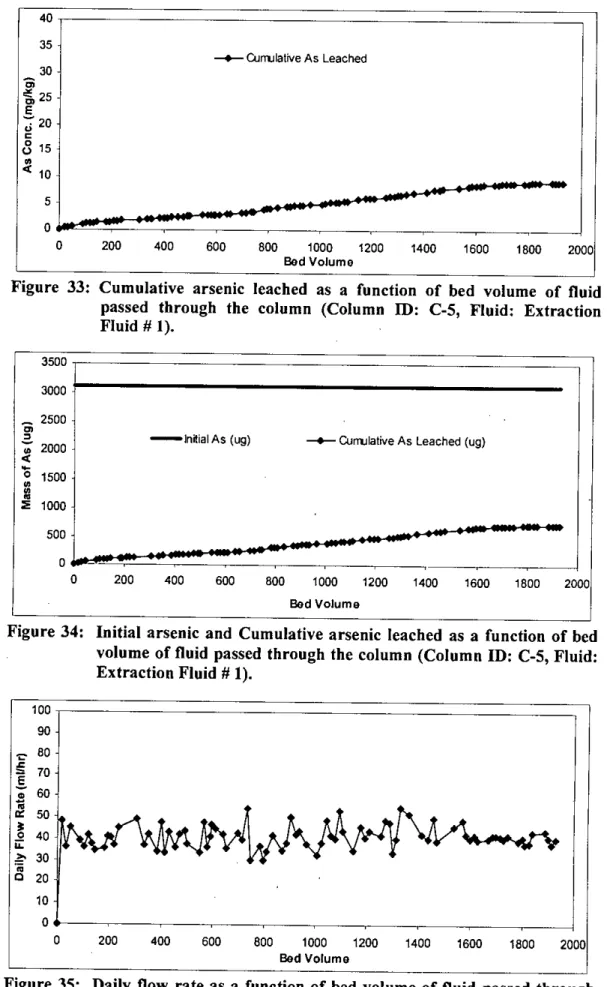
APPENDIXD: TABLES
